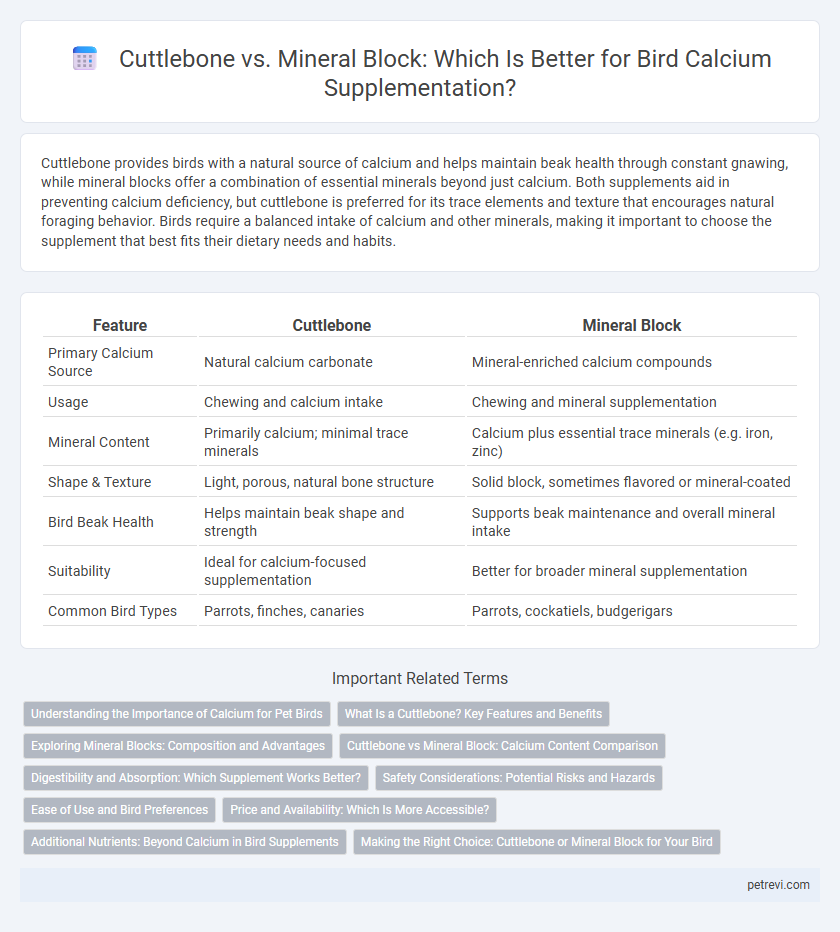Cuttlebone provides birds with a natural source of calcium and helps maintain beak health through constant gnawing, while mineral blocks offer a combination of essential minerals beyond just calcium. Both supplements aid in preventing calcium deficiency, but cuttlebone is preferred for its trace elements and texture that encourages natural foraging behavior. Birds require a balanced intake of calcium and other minerals, making it important to choose the supplement that best fits their dietary needs and habits.
Table of Comparison
| Feature | Cuttlebone | Mineral Block |
|---|---|---|
| Primary Calcium Source | Natural calcium carbonate | Mineral-enriched calcium compounds |
| Usage | Chewing and calcium intake | Chewing and mineral supplementation |
| Mineral Content | Primarily calcium; minimal trace minerals | Calcium plus essential trace minerals (e.g. iron, zinc) |
| Shape & Texture | Light, porous, natural bone structure | Solid block, sometimes flavored or mineral-coated |
| Bird Beak Health | Helps maintain beak shape and strength | Supports beak maintenance and overall mineral intake |
| Suitability | Ideal for calcium-focused supplementation | Better for broader mineral supplementation |
| Common Bird Types | Parrots, finches, canaries | Parrots, cockatiels, budgerigars |
Understanding the Importance of Calcium for Pet Birds
Calcium supplementation is vital for pet birds to maintain strong bones, proper muscle function, and egg production, making sources like cuttlebone and mineral blocks essential. Cuttlebone provides a natural form of calcium along with trace minerals, while mineral blocks often contain a blend of calcium and other nutrients tailored for bird health. Choosing the right supplement supports skeletal strength and prevents calcium deficiency-related issues such as metabolic bone disease in pet birds.
What Is a Cuttlebone? Key Features and Benefits
A cuttlebone is a natural, porous internal shell from cuttlefish, rich in calcium carbonate, essential for birds' bone health and eggshell formation. Its unique texture promotes beak trimming and prevents overgrowth, supporting overall beak maintenance. Compared to mineral blocks, cuttlebones provide a more natural source of calcium and encourage foraging behavior, enhancing birds' mental stimulation and physical activity.
Exploring Mineral Blocks: Composition and Advantages
Mineral blocks for bird calcium supplementation typically contain a blend of essential minerals such as calcium carbonate, phosphorus, and trace elements like zinc and magnesium, offering a balanced nutrient profile. These blocks help maintain bone health, support eggshell formation, and promote overall mineral intake through natural pecking behavior. Compared to cuttlebone, mineral blocks provide a more diverse range of minerals and longer-lasting consumption for birds in captivity.
Cuttlebone vs Mineral Block: Calcium Content Comparison
Cuttlebone contains approximately 38% calcium carbonate, making it a highly concentrated natural calcium source for birds. Mineral blocks typically contain a mixture of minerals with calcium content ranging from 15% to 25%, often combined with other nutrients to support overall health. Birds consuming cuttlebone benefit from its higher calcium density, which is crucial for eggshell formation and bone strength compared to the more generalized mineral block.
Digestibility and Absorption: Which Supplement Works Better?
Cuttlebone provides a natural calcium source with high bioavailability, promoting efficient digestion and absorption for bird bone health. Mineral blocks often contain a blend of calcium and trace minerals, but their digestibility can vary depending on composition and bird species. Studies indicate that birds tend to absorb calcium from cuttlebone more effectively, enhancing skeletal strength and egg production.
Safety Considerations: Potential Risks and Hazards
Cuttlebone and mineral blocks provide essential calcium supplementation for birds, but safety considerations vary between the two. Cuttlebone poses minimal risk as it is natural and generally well-tolerated, though sharp edges can cause beak or mouth injuries if not properly maintained. Mineral blocks may contain additives or trace toxins, increasing the potential for ingestion of harmful substances, so sourcing high-quality, toxin-free blocks is crucial to minimize hazards.
Ease of Use and Bird Preferences
Cuttlebone offers a natural, lightweight source of calcium with a texture that many birds prefer for pecking, promoting beak health while being easy to place in cages. Mineral blocks provide a more compact, longer-lasting option but may require birds to adapt to their harder surface, potentially affecting initial acceptance. Bird preferences vary, with cuttlebone generally favored for its porous consistency, while mineral blocks appeal to species that enjoy harder chewing materials.
Price and Availability: Which Is More Accessible?
Cuttlebone tends to be more affordable and widely available in pet stores and online retailers compared to mineral blocks, which can vary in price and may be less commonly stocked. The natural, renewable source of cuttlebone also provides cost-effective calcium supplementation for birds. For bird owners prioritizing accessibility and budget, cuttlebone often represents the more practical choice.
Additional Nutrients: Beyond Calcium in Bird Supplements
Cuttlebone provides not only calcium but also trace minerals such as magnesium and phosphorus that support bone health and metabolic functions in birds. Mineral blocks offer a broader spectrum of essential nutrients including sodium, potassium, and zinc, which aid in electrolyte balance and overall immunity. Selecting the right supplement depends on the bird species' specific dietary needs and the diversity of nutrients required beyond calcium.
Making the Right Choice: Cuttlebone or Mineral Block for Your Bird
Choosing the right calcium supplement for your bird involves understanding the benefits of cuttlebone versus mineral blocks. Cuttlebone is a natural source of calcium and essential minerals that supports beak health and bone strength, favored for its digestibility and constant availability. Mineral blocks offer a balanced mineral profile and can include additional nutrients like iodine and trace elements, making them ideal for birds requiring a diverse nutrient intake.
Cuttlebone vs Mineral block for Bird calcium supplementation Infographic

 petrevi.com
petrevi.com